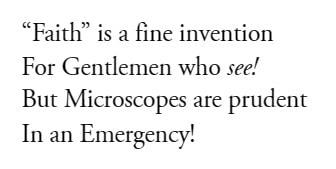According to an article on Wikipedia, “the concept of a palindrome can be dated to the 3rd-century BCE, although no examples survive” (hmm, I wonder how they know that), and “the word ‘palindrome’ was introduced by English poet and writer Henry Peacham in 1638.”
Did Emily Dickinson ever use the word “palindrome” in any of her poems?
Nope.
No surprise there, huh?
However, as I explored “Dickinson” and “palindrome,” I came across this article called, “Palindrome as Portal, Existence as Performance: On Danielle Blau’s ‘peep,’” and it mentions Dickinson; here’s a bit from the article:
“Emily Dickinson famously loved ‘noon,’ that infinite word, and it is this relationship between language and time that excites and delights throughout peep. Blau is drawn to this play with multiplicity, repetition, self-revision, and erasure across many motifs — boxes with peepholes, one-way mirrored bathroom walls in a restaurant called peep. These poems come to function like palindromes, as portals through the pain and pleasure of experience, the illusions of relationships, and the performativity of expression, maybe even existence, itself.”
Dickinson is mentioned a couple other times, and the complete article is HERE.
I also found this – a page of “Short Palindrome Poems” on the PoemHunter.com site -- HERE.
The page includes two poems by Dickinson, “‘Faith’ is a fine invention” and “There is no frigate like a book,” but I’ll admit – I’m confused. What makes these poems “Palindrome Poems”?
If you suffer from the irrational fear of palindromes – called “aibohphobia” (LOL) – then you might have a rough time for these next ten days! However, if you love palindromes – a condition known as “ailihphilia” – then you might enjoy this link HERE, a list of the “355 Best Palindromes in English."


 RSS Feed
RSS Feed
